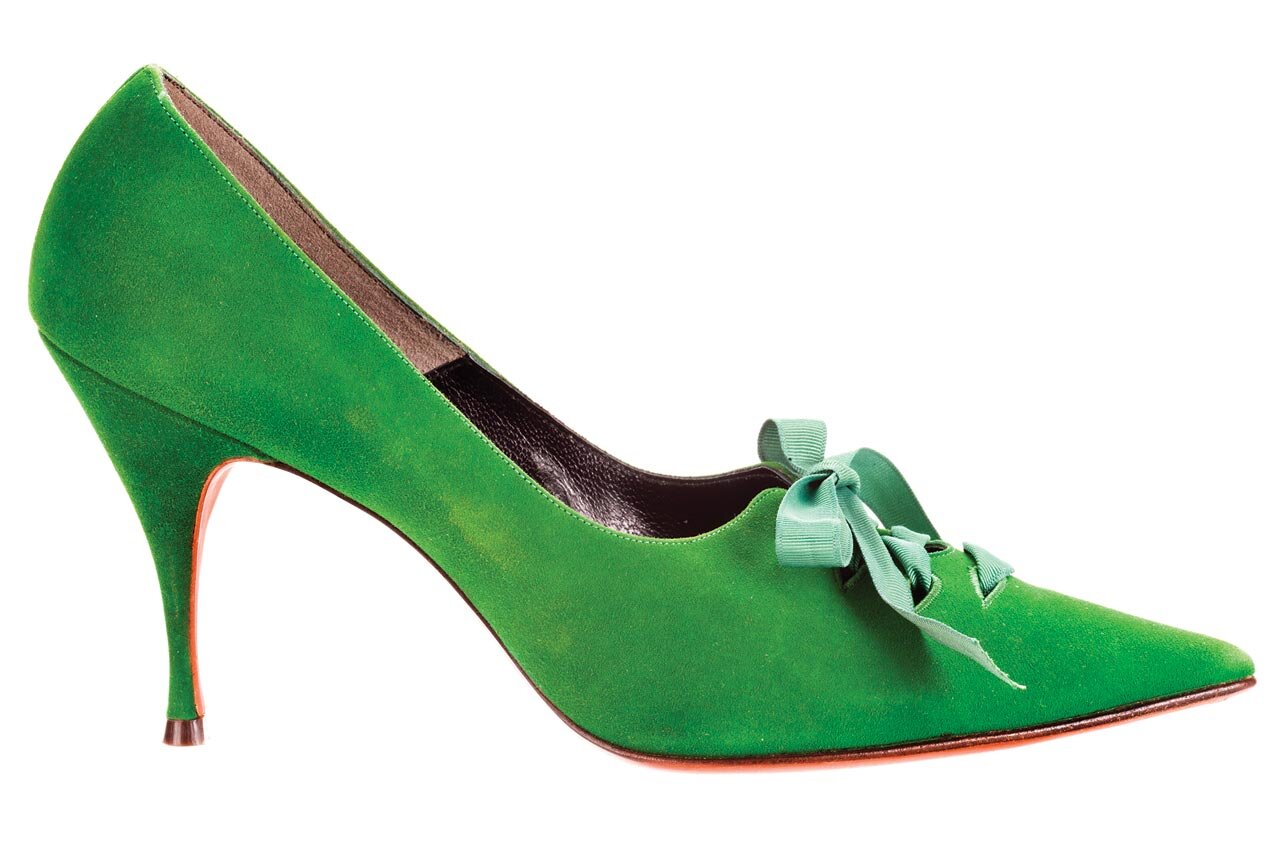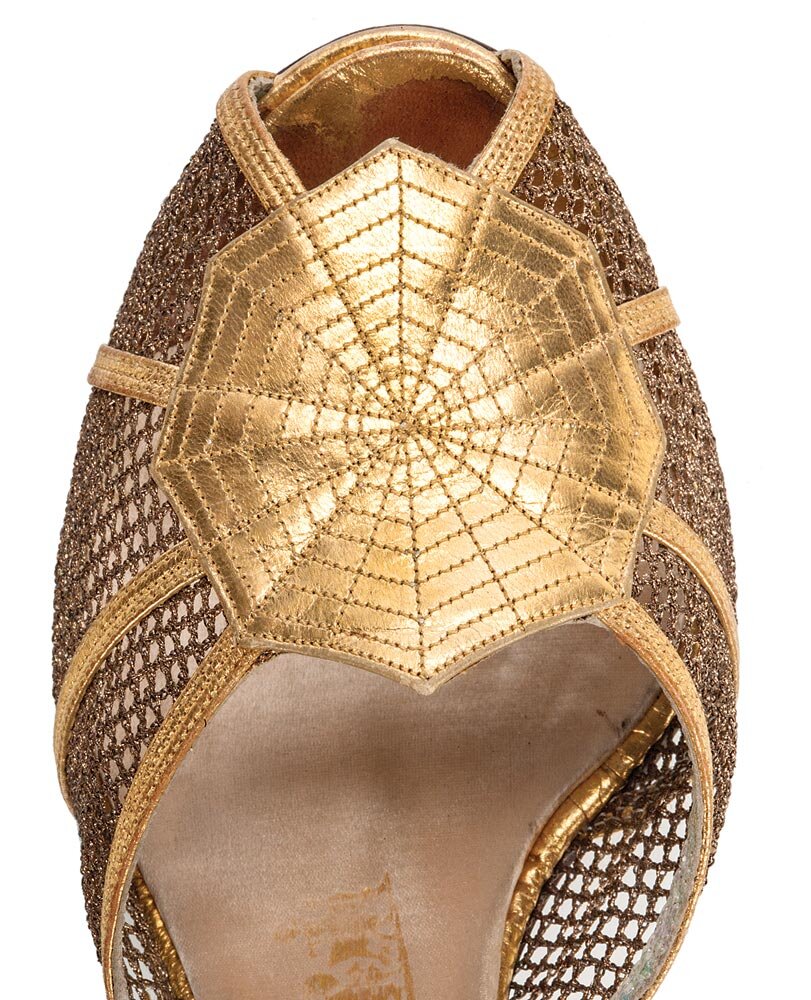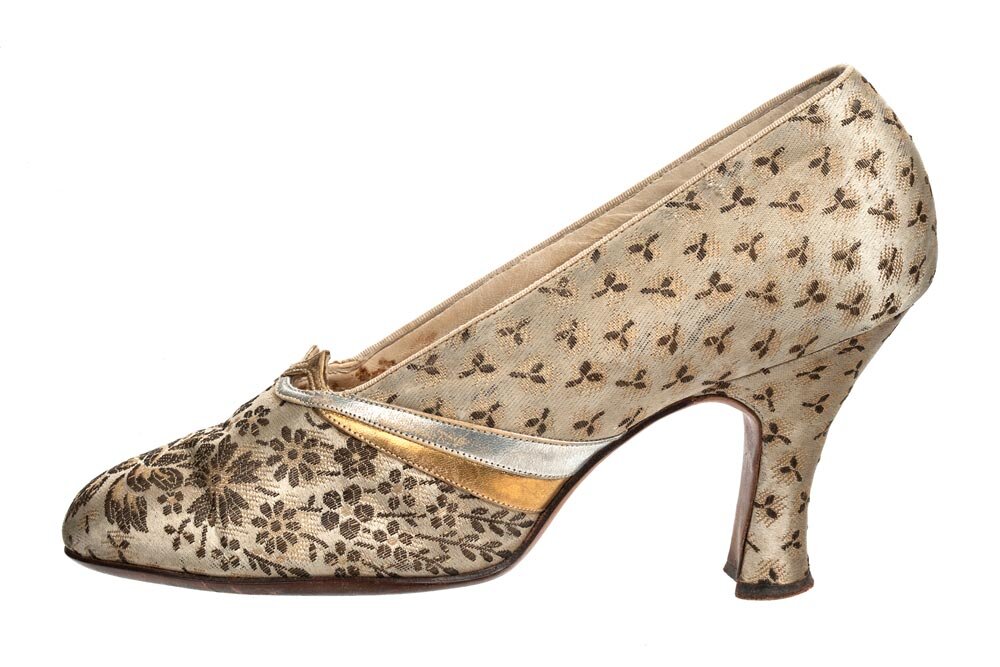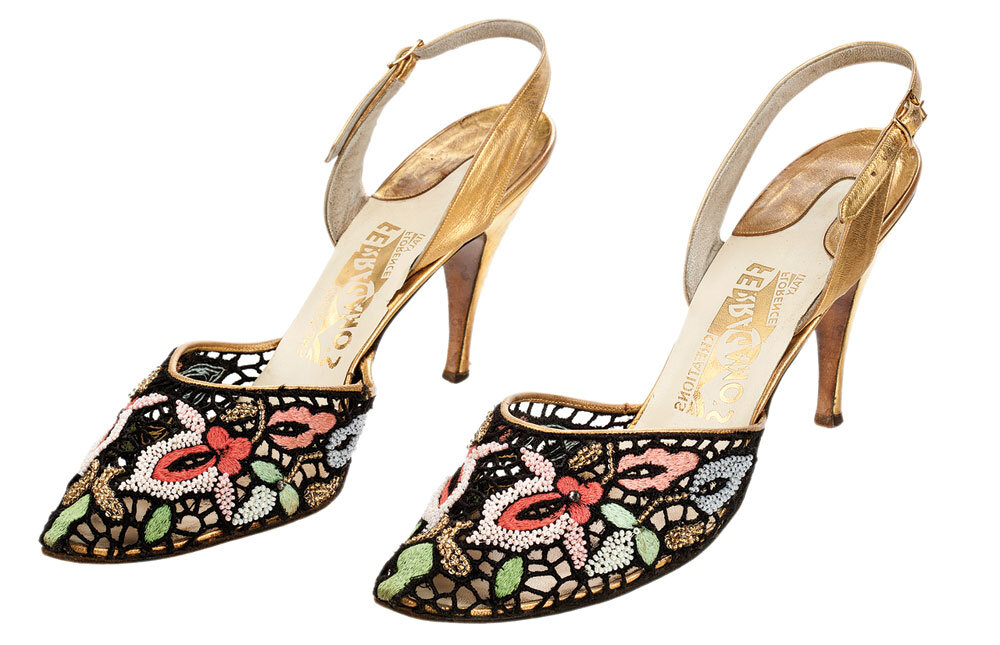SHOE STORIES
Stuart Weitzman was both a shoe collector, and a shoemaker.
LACE-UP BOOTS of silk and silk brocade, circa 1900. The late 1800s saw the introduction of machines capable of mimicking even the most intricate hand shoemaking processes, and producing high-quality shoes. By 1900, nearly every American shoe was made in a mechanized factory. One-third of the workers in these factories were women, at a time when women made up less than twenty percent of the total industrial workforce.
What do you get the shoe designer who has everything? More shoes, of course. Shoe designer Stuart Weitzman is not just a cobbler but a collector of historic shoes—most of them gifts he received from his wife, Jane Gershon Weitzman, over fifty years, sourced from auction houses and antique stores. The result is a wonderfully personal collection of beautiful and unusual shoes, recently on view in the New-York Historical Society’s exhibition “Walk This Way: Footwear from the Stuart Weitzman Collection of Historic Shoes” and its accompanying catalogue. Plans are reportedly afoot for Weitzman (who also collects rare stamps) to open his own museum to showcase his passions.
Rather than attempt to assemble an encyclopedic array of historical shoes, from sandals to stilettos, the Weitzmans have created a designer’s collection, highlighting the beautiful and the unusual. Guided by their own tastes and interests rather than an academic agenda, they have prioritized depth over breadth, giving special attention to a handful of favorite styles and designers. The earliest example on display in the exhibition was a pair of white silk bridal shoes worn in 1838. The flat-soled, square-toed slippers resemble ballet shoes—and, indeed, modern ballet shoes evolved from these simple street shoes, which survived on stage long after fashion moved on to more complex confections. “Dance” is as close as the collection gets to athleticism; there are no statement sneakers here.
Indeed, several categories of shoes are entirely absent. A few pairs chosen for their provenances rather than their design elements—like spectator pumps signed by the 1936 Yankees, or shoes worn on 9/11—stand out as anomalies. There are hardly any men or children’s shoes, and the show included only a few pairs created by Weitzman himself. However, his father, the talented Massachusetts-based shoemaker Seymour Weitzman, was well represented, notably by a pointed-toe pump in apple green suede with pale blue-green grosgrain ribbon lacing. The younger Weitzman—who graduated from the University of Pennsylvania’s Wharton School in 1963—was already planning a career on Wall Street when he decided to follow in his father’s footsteps, undoubtedly seeing the potential for expanding the family business, Seymour Shoes, into the global behemoth it is today. Long before Jimmy Choo and Manolo Blahnik became household names, Weitzman was creating “It” shoes for celebrities and socialites. Weitzman only retired from designing last year, having sold his namesake company to Coach for $574 million in 2015.
POINTED-TOE LACED PUMPS of suede, grosgrain ribbon, by Seymour Weitzman, circa 1964. These shoes were manufactured in Haverhill, Massachusetts, at a factory owned by Seymour Weitzman (1910-1965), a shoe designer and father of Stuart Weitzman. Massachusetts was the earliest center of large-scale shoe production in the United States. PEEP-TOE EVENING SHOES of leather and mesh net, by Delman, London, circa 1935. PUMPS of silk and leather, late 1920s.
Many of the shoes in the Weitzman collection are notable for their technological innovations or gimmicks, and must have been purchased with design inspiration in mind, though they also qualify as works of art in their own right. There are early examples of slingbacks, including one dating to the 1890s. Another method of keeping mules from flying off was the Spring-o-lator of the 1950s, a patented device built into the sole that caused it to hug the instep, helping the shoe adhere to the wearer’s foot. But virtually every object in the collection is exceptional in some way. Many incorporate rare or surprising materials, like linen, wood and mother-of-pearl. Surface ornamentation includes embroidery, beading, appliqué, and intricate basket-weaving. Fans of Weitzman’s shoes will spot themes and materials the designer has repeatedly incorporated into his own work: architectural details, strappy gold sandals, peep toes, cork, clear vinyl, diamanté, T-straps, lucite, and decorative heels. Does he collect them because they appeal to his aesthetic sense, or has the collection itself influenced his personal style? Probably a bit of both.
PEEP-TOE PLATFORM SHOES of suede and leather, by Terry de Havilland, London, circa 1972. Celebrities from actress Marlene Dietrich to dancer Carmen Miranda popularized platform shoes in the late 1930s and 1940s. By the 1970s, platforms were back in fashion for both women and men. The glam-rock London shoemaker Terry de Havilland provided high-heeled shoes for gender-bending performers including David Bowie and Tim Curry in The Rocky Horror Picture Show.
It’s easy to divine which innovative designers throughout history Weitzman most admires. There’s Enzo of Roma, who made animal-shaped flats in the 1960s, long before Charlotte Olympia ever thought to do so. “King of Pumps” David Evins shod royalty and Hollywood royalty—and, in the case of his longtime client Grace Kelly, both. “Rock ‘n’ Roll Cobbler” Terry de Havilland was the Londoner who provided high-heeled platform shoes for gender-bending, glam-rock performers including David Bowie and Tim Curry in The Rocky Horror Picture Show. The collection also includes several early and influential female designers, including Mabel Julianelli, the inventor of the so-called “naked shoe;” Margaret Clark, who designed a series of shoes inspired by Piet Mondrian’s artwork in 1954, well before Yves Saint Laurent had the idea; and Arsho Baghsarian, herself the subject of a new book, for which Weitzman has written the introduction. Both Evins and Julianelli also designed for Fenton Last, Saks Fifth Avenue’s in-house label. Though hardly household names today, these men and women are revered among shoe collectors and aficionados.
Perhaps none is more prominently featured in the collection than “First Lady of Shoe Design” Beth Levine, who named her company after her husband, Herbert Levine, because “the name sounded like a shoemaker,” she once explained. Her 1964 “Kabuki” platforms anticipated Vivienne Westwood’s “Rocking Horse” shoes by three decades, and her 1965 “Race Car” shoes beat Kate Spade’s “Taxi” flats to the finish line by an even wider margin. After Nancy Sinatra wore Levine’s knee-high white boots with angular toes and heels in publicity shots for her 1965 hit “These Boots Are Made for Walkin’,” Saks opened a special section in its shoe department called “Beth’s Bootery” to meet the demand for similar footwear. But Levine’s most audacious design was the topless “No” shoe of 1955. It was nothing more than a high heel attached to a sole; the shoes were sold with bottles of adhesive to glue the bottoms of the feet to the shoes, as there was no upper to keep them on.
While the catalogue is a fascinating peek into Weitzman’s closet, the show itself—produced under the auspices of the New-York Historical Society’s Center for Women’s History—was less successful, possibly because it tried to impose a historical narrative on a collection that was never intended to support one. The wall text mentioned slavery, women’s suffrage, industrialization, population growth, and other historical touchstones, but the objects on display had nothing to do with them. Most of the pieces in the Weitzman collection are from the twentieth century; by 1900, the mechanization of the American shoe industry was already complete, and rising hemlines were putting women’s shoes on display for the first time. Buttons, buckles, bows, cutouts, colors, and shaped and decorated heels drew attention to the wearer’s feet and fashion sense. Shoes had to flatter the newly-revealed leg, as well, and withstand the increasingly athletic dances (and lifestyles) of the time. The shoe trade, which had long been dependent on a few staple styles, exploded in a host of new colors, materials and patterns, all of which mirrored contemporaneous developments in architecture, interiors and fashion. The sleek lines and metallic sheens of Art Deco extended all the way to the feet; the bold shapes and futuristic materials of the Space Age likewise transformed fashion from head to toe.
The burgeoning film industry fueled footwear trends, as it continues to do to this day. Silent film star Pola Negri reportedly once refused to perform because her shoes did not match her dress, even though it was a black and white film. So-called “sword and sandal” epics such as Samson and Delilah, Quo Vadis, Salome, and The Prodigal allowed Hollywood costume designers to dodge the restrictive Production Code of 1930 on dubious grounds of historical accuracy. Biblical temptresses and Roman empresses defied the Code’s prohibition against semi-nudity, and inspired a fashion for elaborate gold and silver lace-up sandals, which did more to reveal the female leg than conceal it. Celebrities from Marlene Dietrich to Carmen Miranda popularized platform shoes in the late 1930s and 1940s.
Click for Captions
MILLION DOLLAR SANDAL of leather and diamonds, by Stuart Weitzman, 2002. All shoes from the Stuart Weitzman Collection of Historic Shoes. Courtesy of New-York Historical Society Museum & Library; photographs by Glenn Castellano.
Judy Garland’s ruby slippers from 1939’s The Wizard of Oz inspired a number of glittering red shoes in the Weitzman collection. Salvatore Ferragamo created his iconic rainbow platform shoes for Garland, inspired by the film’s song “Over the Rainbow.” Fittingly, Ferragamo’s rise to success had begun with his work for the American Film Company. During World War II, he coped with steel and leather shortages by crafting shoes out of raffia, cellophane and Sardinian cork. After the war, Ferragamo rebuilt his star-studded clientele, designing shoes for Marilyn Monroe, Katharine Hepburn and the Duchess of Windsor. The Weitzman collection includes a shoe he created for Italian actress Sophia Loren, incorporating handmade needlepoint lace from Tuscany.
Weitzman, too, owes much of his success to Hollywood, but his shoes are more likely to be seen on the red carpet than the silver screen. He designed his “Million Dollar Sandal”—a lace-up heel studded with 464 diamonds, which was reputedly the most expensive shoe in the world—for Mulholland Drive star Laura Harring to wear to the 2002 Academy Awards, in an effort to get fashion reporters to pay more attention to shoes. His plan succeeded—a floor-level “shoe cam” soon became a staple of Oscar arrivals coverage—and simultaneously put his label on the fashion map. (The famed shoes opened the New York show, their diamonds now replaced with Swarovski crystals.) In 2013, he introduced the minimalist “Nudist Sandal” with its sensual high heel, ankle strap and barely-there bar across the toes. It’s still ubiquitous on the red carpet today; Weitzman attributes its enduring appeal to being “a clean shoe that goes with 90% of dresses.” In recent years, Weitzman’s shoes have graced the feet of A-listers like Beyoncé, Kate Moss, Lady Gaga, and the Duchess of Cambridge. His 2013 “Highland Boot”—an over-the-knee boot inspired by the patent leather thigh-highs Julia Roberts wore in Pretty Woman—was declared the “Accessory of the Year” by People, firmly catapulting so-called “hooker boots” from the screen to the mainstream. Beth “These Boots Are Made for Walkin’ ” Levine would be proud.
SUGGESTED READING
Julianelli, Jane. The Naked Shoe: The Artistry of Mabel Julianelli. Woodbridge, UK: Antique Collectors’ Club, 2010.
Maeder, Edward. Walk This Way: Footwear from the Stuart Weitzman Collection of Historic Shoes. London: D Giles Limited; New York: New-York Historical Society Museum & Library, 2018.
Semmelhack, Elizabeth. Shoes: The Meaning of Style. London: Reaktion Books, 2017.
Steele, Valerie. Shoe Obsession. New Haven: Yale University Press, 2013.
Verin, Helene. Arsho Baghsarian: A Life in Shoes. Atglen, PA: Schiffer Fashion Press, 2019.
Walford, Jonathan. The Seductive Shoe: Four Centuries of Fashion Footwear. New York: Stewart, Tabori & Chang, 2007.
“Walk This Way: Footwear from the Stuart Weitzman Collection of Historic Shoes” showed April 20 - October 8, 2018 at the New-York Historical Society, 170 Central Park West, New York, New York 10024. Visit their website at www.nyhistory.org.
MADONNA SANDALS of kid leather, Tavarnelle needlepoint lace, embroidery, beads, by Salvatore Ferragamo (1898–1960), Florence, circa 1954–55. This design, which features handmade needlepoint lace from Tuscany, was originally created for the Italian actress Sophia Loren.
BOUDOIR SHOES of silk and metallic thread, by Carlo, retailer, Paris, 1867. These shoes were created especially for the Paris Universal Exposition of 1867. The soles are stamped with the exhibition seal. During the age of European imperial expansion, Western consumers clamored for “exotic” textiles, such as the Turkish gilt-thread embroidery seen on these shoes.
Other Articles By This Author
FROM POMPEII TO
PUSSY HATS IN 365 DAYS
Kimberly Chrisman-Campbell is an art historian specializing in fashion and textiles. She has worked as a curator, consultant and educator for museums and universities around the world. She is the author of Fashion Victims: Dress at the Court of Louis XVI and Marie-Antoinette. Chrisman-Campbell was recently honored by the Costume Society of America, receiving the Betty Kirk Excellence in Research Award. Her latest book Worn on This Day: The Clothes That Made History was recently released by Running Press. In this issue, she offers an intriguing journey through the book, which reveals the stories of clothes worn on specific days throughout history, ancient to modern.








